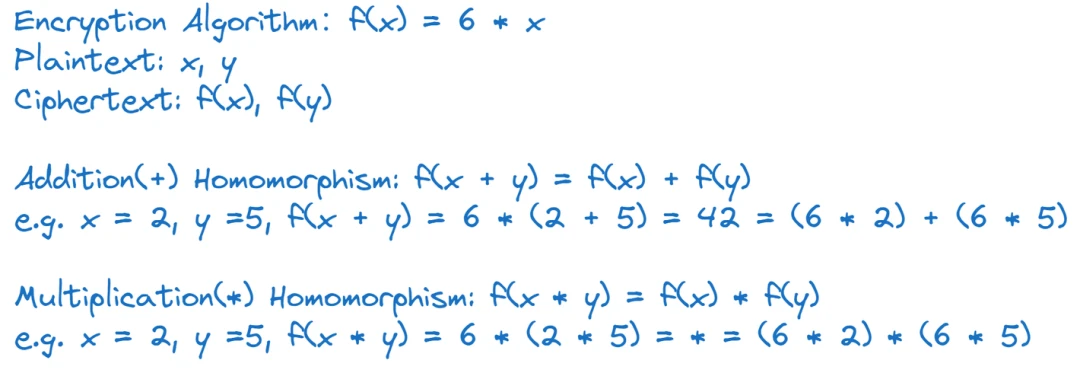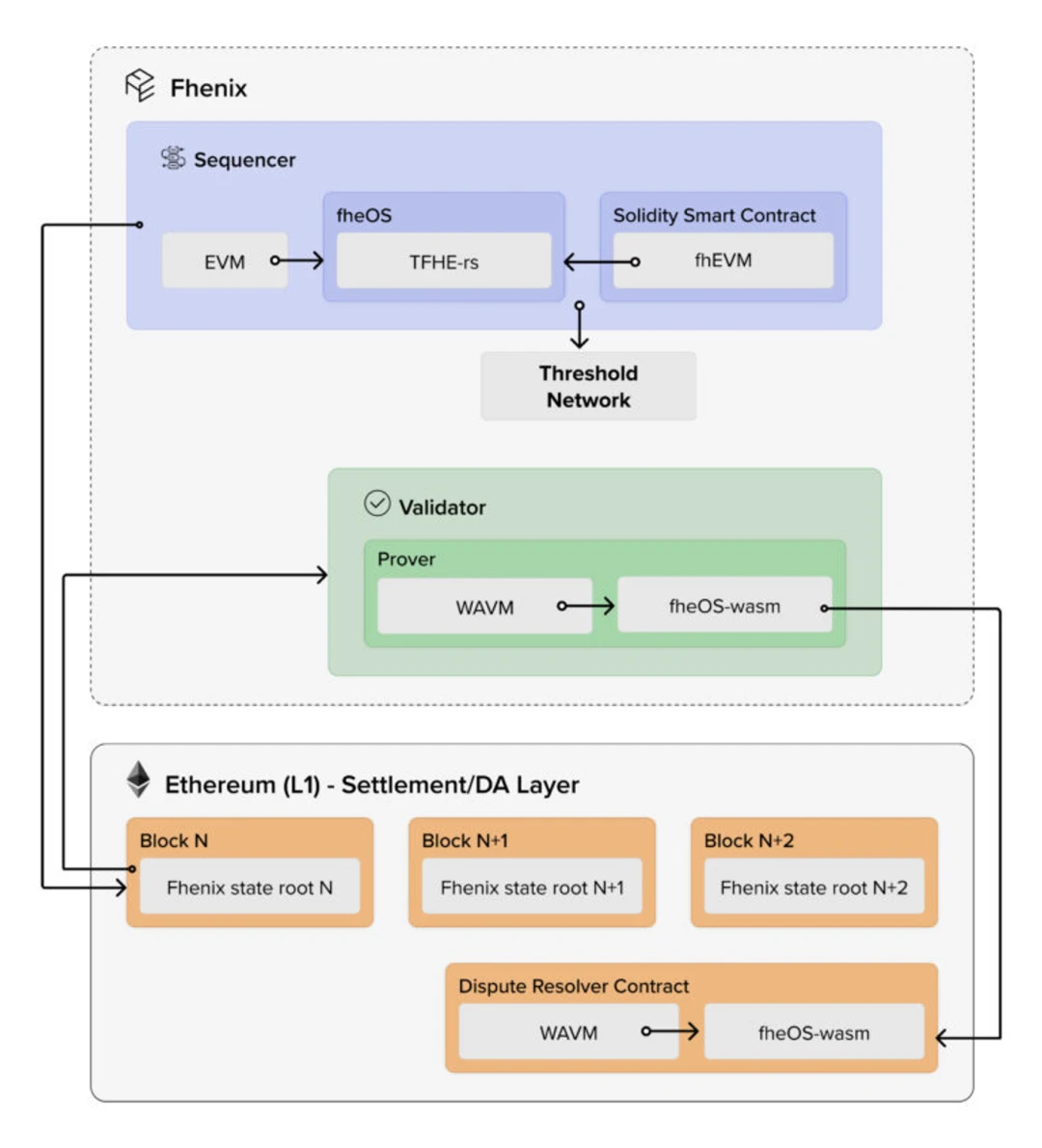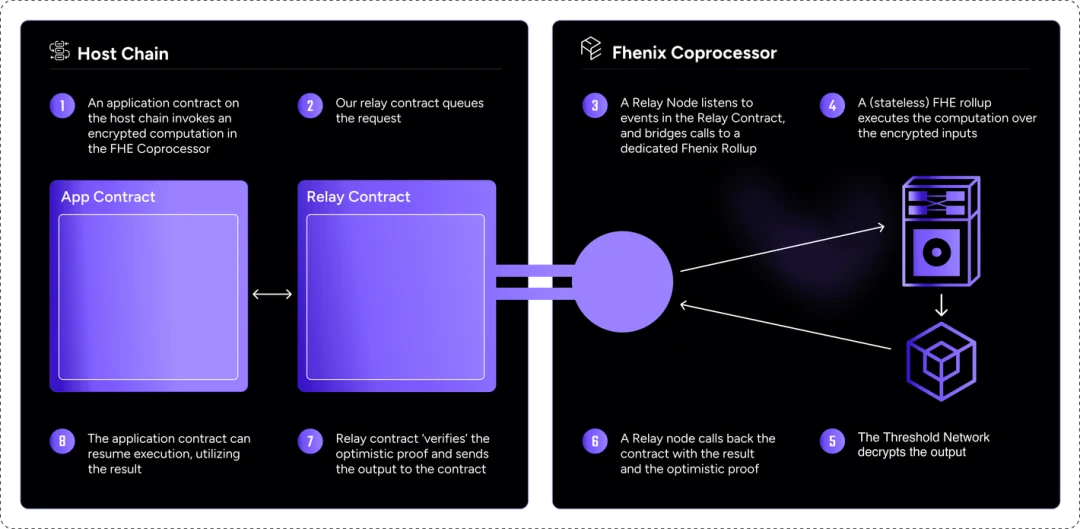ArkStream Capital: Tại sao chúng tôi đầu tư vào chương trình FHE?
Lời nói đầu
Trong quá khứ, công nghệ mật mã đã đóng vai trò then chốt trong sự tiến bộ của nền văn minh nhân loại, đặc biệt là trong lĩnh vực bảo mật thông tin và bảo vệ quyền riêng tư. Nó không chỉ cung cấp khả năng bảo vệ vững chắc cho việc truyền và lưu trữ dữ liệu trong nhiều lĩnh vực mà hệ thống khóa công khai-riêng tư mã hóa bất đối xứng và hàm băm của nó cũng được Satoshi Nakamoto tích hợp một cách sáng tạo vào năm 2008 để thiết kế một cơ chế bằng chứng công việc nhằm giải quyết vấn đề chi tiêu gấp đôi, do đó thúc đẩy sự ra đời của Bitcoin, một loại tiền kỹ thuật số mang tính cách mạng và mở ra một kỷ nguyên mới cho ngành công nghiệp blockchain.
Với sự tiến hóa liên tục và phát triển nhanh chóng của ngành công nghiệp blockchain, một loạt các công nghệ mật mã tiên tiến tiếp tục xuất hiện, trong đó bằng chứng không kiến thức (ZKP), tính toán đa bên (MPC) và mã hóa đồng hình hoàn toàn (FHE) là những công nghệ nổi bật nhất. Các công nghệ này đã được sử dụng rộng rãi trong nhiều tình huống, chẳng hạn như ZKP kết hợp với giải pháp Rollup để giải quyết vấn đề tam giác bất khả thi của blockchain và MPC kết hợp với hệ thống khóa công khai-riêng tư để thúc đẩy ứng dụng cổng thông tin người dùng trên quy mô lớn (Mass Adoption). Đối với mã hóa đồng hình hoàn toàn FHE, được coi là một trong những mục tiêu tối thượng của mật mã học, các đặc điểm độc đáo của nó cho phép bên thứ ba thực hiện bất kỳ số lượng phép tính và thao tác nào trên dữ liệu được mã hóa mà không cần giải mã, do đó hiện thực hóa điện toán riêng tư trên chuỗi có thể cấu hình, mang đến khả năng mới cho nhiều lĩnh vực và tình huống.
Tổng quan nhanh về FHE
Khi chúng ta nói về FHE (Fully Homomorphic Encryption), trước tiên chúng ta có thể hiểu ý nghĩa đằng sau tên của nó. Trước hết, HE là viết tắt của công nghệ mã hóa homomorphic, có đặc điểm cốt lõi là cho phép tính toán và hoạt động trên văn bản mã hóa, và các hoạt động này có thể được ánh xạ trực tiếp sang văn bản thuần túy, tức là các thuộc tính toán học của dữ liệu được mã hóa vẫn không thay đổi. Chữ F trong FHE có nghĩa là homomorphism này đã đạt đến một cấp độ mới, cho phép tính toán và hoạt động không giới hạn trên dữ liệu được mã hóa.
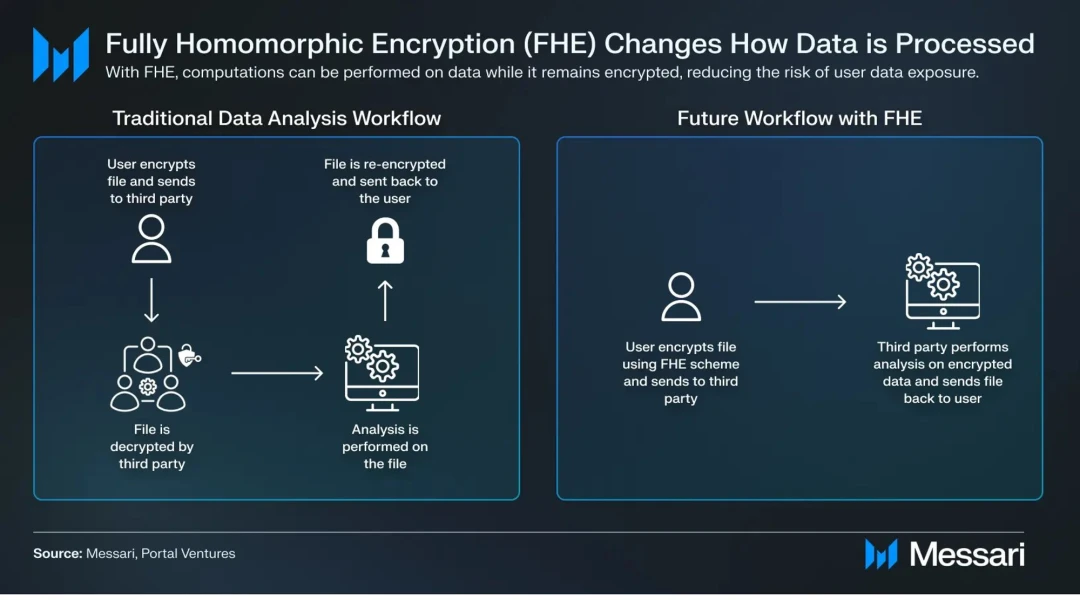 Để giúp hiểu rõ hơn, chúng tôi chọn hàm tuyến tính đơn giản nhất làm thuật toán mã hóa và kết hợp các phép toán đơn lẻ để minh họa phép đồng cấu cộng và phép đồng cấu nhân. Tất nhiên, FHE thực tế sử dụng một loạt các thuật toán toán học phức tạp hơn và các thuật toán này có yêu cầu cực kỳ cao về tài nguyên tính toán (CPU và bộ nhớ).
Để giúp hiểu rõ hơn, chúng tôi chọn hàm tuyến tính đơn giản nhất làm thuật toán mã hóa và kết hợp các phép toán đơn lẻ để minh họa phép đồng cấu cộng và phép đồng cấu nhân. Tất nhiên, FHE thực tế sử dụng một loạt các thuật toán toán học phức tạp hơn và các thuật toán này có yêu cầu cực kỳ cao về tài nguyên tính toán (CPU và bộ nhớ).
Mặc dù các nguyên lý toán học của FHE rất sâu sắc và phức tạp, chúng tôi sẽ không thảo luận chi tiết về chúng ở đây. Cần đề cập rằng trong lĩnh vực mã hóa đồng hình, ngoài FHE, còn có hai dạng khác: mã hóa đồng hình một phần và một số mã hóa đồng hình. Sự khác biệt chính giữa chúng là các loại hoạt động được hỗ trợ và số lượng hoạt động được phép, nhưng chúng cũng cung cấp khả năng thực hiện tính toán và hoạt động của dữ liệu được mã hóa. Tuy nhiên, để giữ cho nội dung ngắn gọn, chúng tôi sẽ không thảo luận sâu về nó ở đây.
Trong ngành FHE, mặc dù có nhiều công ty nổi tiếng tham gia vào nghiên cứu và phát triển, Microsoft và Zama đã chứng minh được tính khả dụng và ảnh hưởng vô song với các sản phẩm nguồn mở tuyệt vời của họ (cơ sở mã). Họ cung cấp cho các nhà phát triển các triển khai FHE ổn định và hiệu quả, và những đóng góp này đã thúc đẩy đáng kể sự phát triển liên tục và ứng dụng rộng rãi của công nghệ FHE.
SEAL của Microsoft: Một thư viện FHE được Microsoft Research xây dựng cẩn thận, không chỉ hỗ trợ mã hóa đồng dạng hoàn toàn mà còn tương thích với mã hóa đồng dạng một phần. SEAL cung cấp giao diện C++ hiệu quả và cải thiện đáng kể hiệu suất và hiệu quả tính toán bằng cách tích hợp nhiều thuật toán và công nghệ tối ưu hóa.
Zamas TFHE: là một thư viện mã nguồn mở tập trung vào mã hóa đồng hình hoàn toàn hiệu suất cao. TFHE cung cấp dịch vụ thông qua giao diện ngôn ngữ C và sử dụng một loạt các kỹ thuật và thuật toán tối ưu hóa tiên tiến để đạt được tốc độ tính toán nhanh hơn và mức tiêu thụ tài nguyên thấp hơn.
Theo ý tưởng đơn giản nhất, quy trình vận hành của trải nghiệm FHE như sau:
-
Tạo khóa: Tạo một cặp khóa công khai và riêng tư bằng thư viện/khung FHE.
-
Dữ liệu được mã hóa: Sử dụng khóa công khai để mã hóa dữ liệu cần được xử lý bằng tính toán FHE.
-
Thực hiện tính toán đồng dạng: Sử dụng hàm tính toán đồng dạng do thư viện FHE cung cấp để thực hiện nhiều phép tính khác nhau trên dữ liệu được mã hóa, chẳng hạn như phép cộng và phép nhân.
-
Kết quả giải mã: Khi cần xem kết quả tính toán, người dùng hợp pháp sẽ sử dụng khóa riêng để giải mã kết quả tính toán.
Trong thực hành FHE, sơ đồ quản lý khóa giải mã (tạo, lưu thông và sử dụng, v.v.) đặc biệt quan trọng. Vì kết quả tính toán và hoạt động của dữ liệu được mã hóa cần được giải mã để sử dụng tại một số thời điểm và tình huống nhất định, nên khóa giải mã trở thành cốt lõi để đảm bảo tính bảo mật và toàn vẹn của dữ liệu gốc và dữ liệu đã xử lý. Về quản lý khóa giải mã, sơ đồ của nó thực sự có nhiều điểm tương đồng với quản lý khóa truyền thống, nhưng xét đến đặc thù của FHE, cũng có thể thiết kế một chiến lược chặt chẽ và chi tiết hơn.
Đối với blockchain, do tính phi tập trung, minh bạch và bất biến của nó, việc giới thiệu một chương trình điện toán bảo mật đa bên ngưỡng (TMPC) là một lựa chọn rất hứa hẹn. Chương trình này cho phép nhiều bên tham gia cùng quản lý và kiểm soát khóa giải mã. Chỉ khi đạt đến số ngưỡng được thiết lập trước (tức là số lượng người tham gia) thì dữ liệu mới có thể được giải mã thành công. Điều này không chỉ cải thiện tính bảo mật của quản lý khóa mà còn giảm nguy cơ một nút duy nhất bị tấn công, mang lại sự đảm bảo mạnh mẽ cho việc áp dụng FHE trong môi trường blockchain.
fhEVM đặt nền móng
Theo quan điểm xâm nhập tối thiểu, cách lý tưởng để triển khai FHE trên blockchain là đóng gói nó như một cơ sở mã hợp đồng thông minh chung để đảm bảo tính di động và linh hoạt. Tuy nhiên, tiền đề của giải pháp này là máy ảo hợp đồng thông minh phải hỗ trợ trước bộ lệnh cụ thể của các phép toán phức tạp và các phép toán mật mã mà FHE yêu cầu. Nếu máy ảo không đáp ứng được các yêu cầu này, cần phải tùy chỉnh sâu và chuyển đổi kiến trúc cốt lõi của máy ảo để thích ứng với nhu cầu của thuật toán FHE để đạt được sự tích hợp liền mạch.
Là một máy ảo được áp dụng rộng rãi và đã được chứng minh từ lâu, EVM tự nhiên trở thành lựa chọn đầu tiên để triển khai FHE. Tuy nhiên, có rất ít người hành nghề trong lĩnh vực này. Trong số đó, chúng tôi một lần nữa chú ý đến Zama, công ty đã mã nguồn mở TFHE. Hóa ra Zama không chỉ cung cấp thư viện TFHE cơ bản mà còn là một công ty công nghệ tập trung vào việc áp dụng công nghệ FHE vào các lĩnh vực trí tuệ nhân tạo và blockchain, đã ra mắt hai sản phẩm mã nguồn mở quan trọng: Concrete ML và fhEVM. Concrete ML tập trung vào tính toán quyền riêng tư của máy học. Thông qua Concrete ML, các nhà khoa học dữ liệu và người hành nghề ML có thể đào tạo và suy ra các mô hình máy học trên dữ liệu nhạy cảm trong khi vẫn bảo vệ quyền riêng tư, do đó tận dụng tối đa các tài nguyên dữ liệu mà không lo bị rò rỉ quyền riêng tư. Một sản phẩm khác, fhEVM, là EVM hoàn toàn đồng dạng hỗ trợ Solidity để triển khai tính toán quyền riêng tư. fhEVM cho phép các nhà phát triển sử dụng công nghệ mã hóa hoàn toàn đồng dạng trong các hợp đồng thông minh Ethereum để đạt được tính năng bảo vệ quyền riêng tư và tính toán an toàn.
Khi đọc tài liệu fhEVM, chúng tôi biết được các tính năng cốt lõi của fhEVM là:
-
fhEVM: Ở cấp độ bytecode không phải EVM, nó cung cấp hỗ trợ FHE dưới dạng các hàm nhúng bằng cách tích hợp nhiều hợp đồng được biên dịch trước ở các trạng thái khác nhau của thư viện FHE nguồn mở Zama. Ngoài ra, một vùng lưu trữ và bộ nhớ EVM cụ thể được tạo riêng cho FHE để lưu trữ, đọc, ghi và xác minh văn bản mã hóa FHE;
-
Cơ chế giải mã dựa trên thiết kế giao thức ngưỡng phân tán: hỗ trợ khóa FHE toàn cầu và lưu trữ khóa mã hóa trên chuỗi cho dữ liệu được mã hóa hỗn hợp giữa nhiều người dùng và nhiều hợp đồng, và cơ chế mã hóa không đồng bộ để chia sẻ khóa giải mã giữa nhiều trình xác thực bằng cách sử dụng lược đồ tính toán bảo mật nhiều bên ngưỡng;
-
Thư viện hợp đồng Solidity giúp giảm ngưỡng để các nhà phát triển sử dụng: Thiết kế các kiểu dữ liệu mã hóa FHE, kiểu hoạt động, lệnh gọi giải mã và đầu ra mã hóa;
Zamas fhEVM cung cấp một điểm khởi đầu vững chắc cho công nghệ FHE trong các ứng dụng blockchain, nhưng xét đến việc Zama chủ yếu tập trung vào nghiên cứu và phát triển công nghệ, các giải pháp của họ mang tính kỹ thuật hơn và có tương đối ít cân nhắc đến việc triển khai kỹ thuật và ứng dụng thương mại. Do đó, trong quá trình thúc đẩy fhEVM vào các ứng dụng thực tế, họ có thể gặp phải nhiều thách thức bất ngờ, bao gồm nhưng không giới hạn ở các rào cản kỹ thuật và tối ưu hóa hiệu suất.
Xây dựng hệ sinh thái FHE-Rollups
Bản thân fhEVM thuần túy không thể tự mình tạo thành một dự án hoặc một hệ sinh thái hoàn chỉnh. Nó giống như một trong những khách hàng đa dạng trong hệ sinh thái Ethereum hơn. Nếu fhEVM muốn trở thành một dự án độc lập, nó phải dựa vào kiến trúc cấp chuỗi công khai hoặc áp dụng các giải pháp Lớp 2/Lớp 3. Hướng phát triển của chuỗi công khai FHE tất yếu phải giải quyết cách giảm sự dư thừa và lãng phí tài nguyên điện toán FHE giữa các nút xác thực phân tán. Ngược lại, giải pháp Lớp 2/Lớp 3, tồn tại như lớp thực thi của chính chuỗi công khai, có thể phân phối công việc điện toán cho một số lượng nhỏ các nút, giúp giảm đáng kể thứ tự độ lớn của chi phí điện toán. Vì lý do này, Fhenix, với tư cách là người tiên phong, đang tích cực khám phá sự kết hợp giữa công nghệ fhEVM và Rollup, đồng thời đề xuất xây dựng giải pháp Lớp 2 tiên tiến kiểu FHE-Rollups.
Xem xét rằng công nghệ ZK Rollups liên quan đến các cơ chế ZKP phức tạp và đòi hỏi các nguồn tài nguyên tính toán khổng lồ để tạo ra các bằng chứng cần thiết cho việc xác minh, kết hợp với các đặc điểm của bản thân FHE đầy đủ, việc triển khai trực tiếp giải pháp FHE-Rollups dựa trên ZK Rollups sẽ phải đối mặt với nhiều thách thức. Do đó, ở giai đoạn này, so với ZK Rollups, việc sử dụng giải pháp Optimistic Rollups làm lựa chọn kỹ thuật của Fhenixs thực tế và hiệu quả hơn.
Bộ công nghệ của Fhenix chủ yếu bao gồm các thành phần chính sau: Một biến thể của Arbitrum Nitros fraud prover, có thể thực hiện bằng chứng gian lận trong WebAssembly, do đó logic FHE có thể được biên dịch thành WebAssembly để vận hành an toàn. Thư viện cốt lõi fheOS cung cấp tất cả các chức năng cần thiết để tích hợp logic FHE vào hợp đồng thông minh. Threshold Service Network (TSN) là một thành phần quan trọng khác, lưu trữ khóa mạng chia sẻ bí mật, chia khóa thành nhiều bản sao bằng công nghệ chia sẻ bí mật với thuật toán cụ thể để đảm bảo an ninh và chịu trách nhiệm cho các tác vụ như giải mã dữ liệu khi cần thiết.
Dựa trên nền tảng công nghệ trên, Fhenix đã phát hành phiên bản công khai đầu tiên của mình, Fhenix Frontier. Mặc dù đây là phiên bản đầu tiên với nhiều hạn chế và thiếu chức năng, nhưng nó đã cung cấp hướng dẫn toàn diện về việc sử dụng cơ sở mã hợp đồng thông minh, API Solidity, chuỗi công cụ phát triển hợp đồng (như Hardhat/Remix), thư viện JavaScript tương tác front-end, v.v. Các nhà phát triển và các bên dự án sinh thái quan tâm đến điều này có thể tham khảo tài liệu chính thức để khám phá.
Bộ đồng xử lý FHE không phụ thuộc chuỗi
Dựa trên FHE-Rollups, Fhenix đã khéo léo giới thiệu mô-đun Relay, nhằm mục đích cho phép nhiều chuỗi công khai, mạng L2 và L3 khác nhau, để chúng có thể truy cập vào Bộ đồng xử lý FHE và sử dụng các chức năng FHE. Điều này có nghĩa là ngay cả khi Chuỗi máy chủ ban đầu không hỗ trợ FHE, giờ đây nó vẫn có thể gián tiếp tận hưởng các chức năng mạnh mẽ của FHE. Tuy nhiên, vì thời gian thử thách bằng chứng của FHE-Rollups thường kéo dài tới 7 ngày, điều này đã hạn chế ứng dụng rộng rãi của FHE ở một mức độ nhất định. Để vượt qua thách thức này, Fhenix đã hợp tác với EigenLayer để cung cấp một kênh nhanh hơn và thuận tiện hơn cho các dịch vụ của Bộ đồng xử lý FHE thông qua cơ chế EigenLayers Resttaking, cải thiện đáng kể hiệu quả và tính linh hoạt của toàn bộ Bộ đồng xử lý FHE.
Quy trình làm việc để sử dụng Bộ đồng xử lý FHE rất đơn giản:
-
Hợp đồng ứng dụng gọi FHE Coprocessor trên Host Chain để thực hiện các phép tính mật mã
-
Yêu cầu hàng đợi hợp đồng chuyển tiếp
-
Nút Relay lắng nghe hợp đồng Relay và chuyển tiếp cuộc gọi đến Fhenix Rollup chuyên dụng
-
FHE Rollup thực hiện các hoạt động tính toán FHE
-
Ngưỡng đầu ra giải mã mạng
-
Nút chuyển tiếp gửi kết quả và bằng chứng lạc quan trở lại hợp đồng
-
Hợp đồng xác minh bằng chứng lạc quan và gửi kết quả cho người gọi
-
Áp dụng hợp đồng và tiếp tục thực hiện hợp đồng dựa trên kết quả cuộc gọi
Hướng dẫn tham gia Fhenix
Nếu bạn là nhà phát triển, bạn có thể nghiên cứu tài liệu của Fhenix và phát triển các ứng dụng dựa trên FHE của riêng bạn dựa trên các tài liệu này để khám phá tiềm năng của nó trong các ứng dụng thực tế.
Nếu bạn là người dùng, bạn cũng có thể dùng thử dApp do Fhenixs FHE-Rollups cung cấp để trải nghiệm tính bảo mật dữ liệu và bảo vệ quyền riêng tư do FHE mang lại.
Nếu bạn là nhà nghiên cứu, chúng tôi khuyên bạn nên đọc kỹ tài liệu của Fhenix để hiểu sâu hơn về các nguyên tắc, thông tin kỹ thuật và triển vọng ứng dụng của FHE để có thể đóng góp có giá trị hơn cho lĩnh vực nghiên cứu của mình.
Thực hành tốt nhất của FHE
Công nghệ FHE đã cho thấy triển vọng ứng dụng rộng rãi, đặc biệt là trong các lĩnh vực trò chơi chuỗi đầy đủ, DeFi và AI. Chúng tôi tin chắc rằng nó có tiềm năng phát triển rất lớn và không gian ứng dụng rộng rãi trong các lĩnh vực này:
-
Trò chơi chuỗi đầy đủ được bảo vệ quyền riêng tư: Công nghệ FHE cung cấp bảo vệ mã hóa mạnh mẽ cho các giao dịch tài chính và hoạt động của người chơi trong nền kinh tế trò chơi, ngăn chặn hiệu quả việc thao túng thời gian thực và đảm bảo tính công bằng và vô tư của trò chơi. Đồng thời, FHE cũng có thể ẩn danh các hoạt động của người chơi, giảm đáng kể nguy cơ rò rỉ tài sản tài chính và thông tin cá nhân của người chơi, do đó bảo vệ an ninh quyền riêng tư của người chơi ở mọi khía cạnh.
-
DeFi/MEV: Với sự phát triển bùng nổ của các hoạt động DeFi, nhiều hoạt động DeFi đã trở thành mục tiêu của các cuộc tấn công MEV trong Dark Forest. Để giải quyết thách thức này, FHE có thể bảo vệ hiệu quả dữ liệu nhạy cảm mà DeFi không muốn tiết lộ, chẳng hạn như số lượng vị thế, dòng thanh lý, trượt giá giao dịch, v.v., đồng thời đảm bảo tính toán và xử lý logic kinh doanh. Bằng cách áp dụng FHE, sức khỏe của DeFi trên chuỗi có thể được cải thiện đáng kể, do đó làm giảm đáng kể tần suất hành vi MEV xấu.
-
AI: Việc đào tạo các mô hình AI phụ thuộc vào các tập dữ liệu. Khi nói đến việc sử dụng dữ liệu cá nhân để đào tạo, việc đảm bảo tính bảo mật của dữ liệu nhạy cảm cá nhân trở thành tiền đề chính. Vì lý do này, công nghệ FHE đã trở thành giải pháp lý tưởng để đào tạo các mô hình AI với dữ liệu riêng tư cá nhân. Nó cho phép AI xử lý trên dữ liệu được mã hóa, do đó hoàn thành quá trình đào tạo mà không làm rò rỉ bất kỳ thông tin nhạy cảm cá nhân nào.
Sự công nhận của cộng đồng đối với FHE
Sự phát triển của công nghệ không thể đạt được chỉ bằng các đặc điểm cốt lõi của nó. Để đạt được sự trưởng thành và tiến bộ liên tục của công nghệ, nó phải dựa vào sự cải tiến liên tục của nghiên cứu và phát triển học thuật và xây dựng tích cực sức mạnh cộng đồng. Về mặt này, FHE được gọi là chén thánh của cộng đồng mật mã, và tiềm năng và giá trị của nó từ lâu đã được công nhận rộng rãi. Vào năm 2020, Vitalik Buterin đã công nhận và ủng hộ công nghệ FHE trong bài viết Khám phá mã hóa đồng hình hoàn toàn của mình. Gần đây, ông đã phát biểu một lần nữa trên phương tiện truyền thông xã hội, điều này chắc chắn đã củng cố lại vị trí này và kêu gọi nhiều nguồn lực và sức mạnh hơn cho sự phát triển của công nghệ FHE. Tương ứng, sự xuất hiện của các dự án mới, các tổ chức nghiên cứu và giáo dục phi lợi nhuận, và việc liên tục bơm tiền vào thị trường dường như chỉ ra rằng khúc dạo đầu cho một vụ nổ công nghệ sắp xảy ra.
Hệ sinh thái sớm FHE tiềm năng
Trong giai đoạn đầu phát triển hệ sinh thái FHE, ngoài công ty dịch vụ công nghệ cơ sở hạ tầng cốt lõi Zama và dự án Fhenix rất được mong đợi, còn có một loạt các dự án nổi bật không kém xứng đáng để chúng ta tìm hiểu sâu sắc và chú ý:
-
Sunscreen: Trình biên dịch FHE được xây dựng thông qua quá trình tự phát triển, hỗ trợ chuyển đổi FHE sang các ngôn ngữ lập trình truyền thống, thiết kế bộ lưu trữ phi tập trung mã hóa FHE tương ứng và cuối cùng là xuất các tính năng FHE cho các ứng dụng Web3 dưới dạng SDK
-
Mind Network: Kết hợp với cơ chế EigenLayers Resting, một mạng FHE được thiết kế riêng để mở rộng bảo mật cho mạng AI và DePIN
-
PADO Labs: Ra mắt zkFHE, một mạng lưới điện toán phi tập trung kết hợp ZKP và FHE
-
**Arcium: **Trước đây là giao thức bảo mật Elusiv của Solana, gần đây đã chuyển đổi thành mạng máy tính bảo mật song song kết hợp với FHE
-
Mạng Inco: Dựa trên fhEVM của Zamas, tập trung vào việc tối ưu hóa chi phí tính toán và hiệu quả của FHE, sau đó phát triển Lớp 1 sinh thái hoàn chỉnh
-
Treat: được tạo ra bởi nhóm Shiba và Zama, dành riêng cho việc mở rộng Lớp FHE 3 của hệ sinh thái Shiba
-
octra: Mạng FHE với môi trường thực thi biệt lập dựa trên OCaml, AST, ReasonML và C++
-
BasedAI: Mạng phân tán hỗ trợ việc giới thiệu các khả năng FHE cho các mô hình LLM
-
Encifher: Trước đây là BananaHQ, hiện đổi tên thành Rize Labs, đang làm việc trên FHEML xung quanh FHE
-
Privasea: Một mạng FHE được xây dựng bởi nhóm cốt lõi NuLink, sử dụng khuôn khổ Concrete ML của Zama, được thiết kế để đạt được mục tiêu bảo vệ quyền riêng tư dữ liệu trong quá trình suy luận ML trong lĩnh vực AI
Đối với các tổ chức nghiên cứu và giáo dục phi lợi nhuận, chúng tôi đặc biệt đề xuất FHE.org và FHE Onchain, nơi cung cấp các nguồn tài nguyên có giá trị cho nghiên cứu học thuật và phổ biến giáo dục của toàn bộ hệ sinh thái.
Do không gian có hạn, chúng tôi không thể liệt kê tất cả các dự án tuyệt vời trong hệ sinh thái FHE. Nhưng hãy tin rằng hệ sinh thái này chứa đựng tiềm năng và cơ hội vô hạn, xứng đáng để chúng tôi tiếp tục khám phá và phát triển chuyên sâu.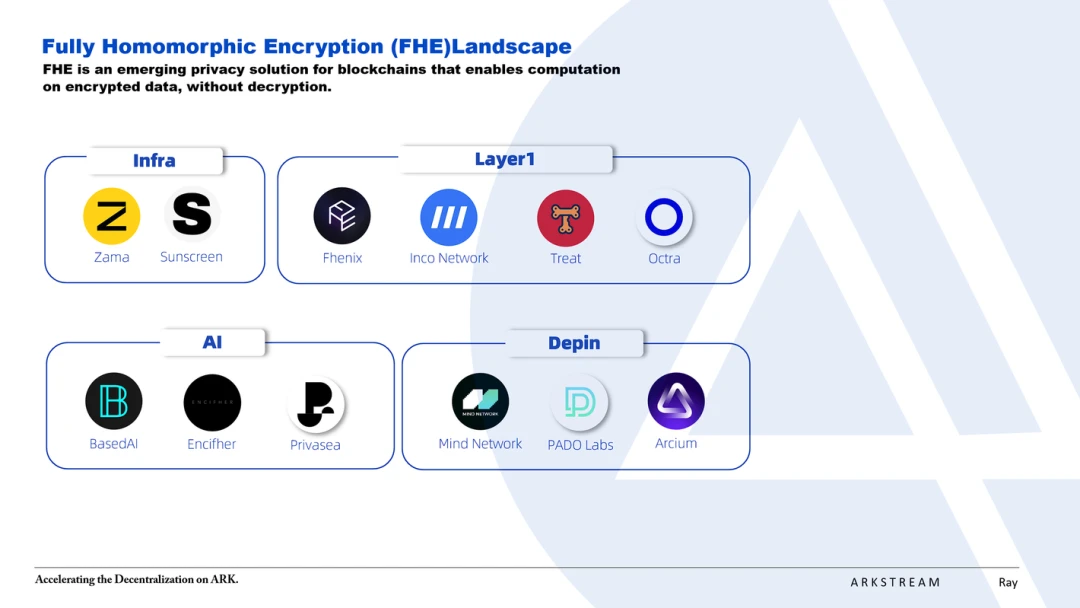
Tóm tắt
Chúng tôi lạc quan về triển vọng của công nghệ FHE và có kỳ vọng cao đối với dự án Fhenix. Khi mạng chính Fhenix được phát hành và chính thức ra mắt, chúng tôi hy vọng rằng các ứng dụng trong các lĩnh vực khác nhau sẽ được cải thiện nhờ công nghệ FHE. Chúng tôi tin chắc rằng tương lai đổi mới và sôi động này đang ở rất gần.
tài liệu tham khảo
https://zama.ai/
https://github.com/microsoft/SEAL
https://www.fhenix.io/
https://mindnetwork.xyz/
https://www.inco.org/
https://x.com/treatsforShib
https://docs.octra.org/
https://x.com/encifherio
https://www.getbased.ai/
https://www.privasea.ai/
https://x.com/fhe_org
https://x.com/FHEOnchain
https://vitalik.eth.limo/general/2020/07/20/homomorphic.html
https://x.com/MessariCrypto/status/1720134959875457352
https://foresightnews.pro/article/detail/59947
Bài viết này có nguồn từ internet: ArkStream Capital: Tại sao chúng tôi đầu tư vào chương trình FHE?
Bài viết gốc của Nina Bambysheva, Forbes Bản dịch gốc: Luffy, Foresight News Vào thời điểm mà phần lớn thế giới tiền điện tử sụp đổ, khi FTX và những gã khổng lồ khác trong ngành đã thất bại, Tether đã nổi bật giữa đám đông và phát triển mạnh mẽ. Đồng tiền ổn định USDT của Tether đã tăng vọt lên $111 tỷ giá trị thị trường, gấp ba lần so với đối thủ cạnh tranh gần nhất là USDC, do Circle có trụ sở tại Boston phát hành. Hoạt động kinh doanh của Tether rất đáng ghen tị vì nguồn tài trợ của họ thực sự miễn phí, nhờ lãi suất cao hơn đối với Kho bạc Hoa Kỳ, chiếm phần lớn dự trữ hỗ trợ cho đồng tiền ổn định tiền điện tử của họ. Không giống như các ngân hàng truyền thống, khách hàng gửi tiền cứng với Tether để đổi lấy USDT sẽ không nhận được bất kỳ khoản lãi nào. Chỉ riêng trong quý đầu tiên của năm 2024, Tether đã báo cáo "kết quả tài chính" chưa được kiểm toán của công ty là $4,5 tỷ và…

